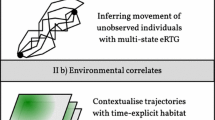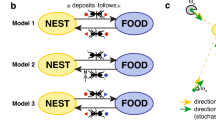Abstract
A mathematical model which incorporates the spatial dispersal and interaction dynamics of mistletoes and birds is derived and studied to gain insights of the spatial heterogeneity in abundance of mistletoes. Fickian diffusion and chemotaxis are used to model the random movement of birds and the aggregation of birds due to the attraction of mistletoes, respectively. The spread of mistletoes by birds is expressed by a dispersal operator, which is typically a convolution integral with a dispersal kernel. Two different types of kernel functions are used to study the model, one is a Dirac delta function which reflects the special case that the spread behavior is local, and the other one is a general non-negative symmetric function which describes the nonlocal spread of mistletoes. When the kernel function is taken as the Dirac delta function, the threshold condition for the existence of mistletoes is given and explored in terms of parameters. For the general non-negative symmetric kernel case, we prove the existence and stability of spatially nonhomogeneous equilibria. Numerical simulations are conducted by taking specific forms of kernel functions. Our study shows that the spatial heterogeneous patterns of mistletoes are related to the specific dispersal pattern of birds which carry mistletoe seeds.















Similar content being viewed by others
References
Alikakos ND (1979a) An application of the invariance principle to reaction-diffusion equations. J Differ Equ 33(2):201–225
Alikakos ND (1979b) \(L^p\) bounds of solutions of reaction diffusion equations. Comm Partial Differ Equ 4(8):827–868
Aukema JE (2003) Vectors, viscin, and viscaceae: mistletoes as parasites, mutualists, and resources. Front Ecol Environ 1(3):212–219
Aukema JE, Martinez del Rio C (2002) Where does a fruit-eating bird deposit mistletoe seeds? seed deposition patterns and an experiment. Ecology 83(12):3489–3496
Aukema JE (2004) Distribution and dispersal of desert mistletoe is scale-dependent, hierarchically nested. Ecography 27(2):137–144
Bannister P, Strong GL (2001) Carbon and nitrogen isotope ratios, nitrogen content and heterotrophy in New Zealand mistletoes. Oecologia 126(1):10–20
Calder M, Bernhardt P (1983) The biology of mistletoes. Academic Press, Sydney
Chang KC (2005) Methods in nonlinear analysis. Springer, Berlin
Chen S, Shi J (2011) Global attractivity of equilibrium in Gierer-Meinhardt system with activator production saturation and gene expression time delays, Submitted
Crandall M, Rabinowitz PH (1971) Bifurcation from simple eigenvalues. J Funct Anal 8(2):321–340
Crandall M, Rabinowitz PH (1973) Bifurcation, perturbation of simple eigenvalues, and linearized stability. Arch Ration Mech Anal 52(2):161–180
del Rio CM, Hourdequin M, Silva A, Medel R (1995) The influence of cactus size and previous infection on bird deposition of mistletoe seeds. Aust J Ecol 20(4):571–576
del Rio CM, Silva A, Medel R, Hourdequin M (1996) Seed dispersers as disease vectors: bird transmission of mistletoe seeds to plant hosts. Ecology 77:912–921
Gourley SA, So J (2002) Dynamics of a food-limited population model incorporating nonlocal delays on a finite domain. J Math Biol 44(1):49–78
Gourley SA, So J, Wu J (2004) Nonlocality of reaction-diffusion equations induced by delay: biological modeling and nonlinear dynamics. J Math Sci 124(4):5119–5153
Gourley SA, Wu J (2006) Delayed non-local diffusive systems in biological invasion and disease spread. In: Nonlinear dynamics and evolution equations, vol 48. Fields Institute Communications. American Mathematical Society, Providence, RI, pp 137–200
Hillen T, Painter KJ (2009) A user’s guide to PDE models for chemotaxis. J. Math Biol 58(1–2):183–217
Holling CS (1959a) The components of predation as revealed by a study of small mammal predation on the European pine sawfly. Can Ent 91(5):293–320
Holling CS (1959b) Some characteristics of simple types of predation and parasitism. Can Ent 91(7):385–398
Horstmann D, Winkler M (2005) Boundedness vs. blow-up in a chemotaxis system. J Diff Equ 215(1):52–107
Hull RJ, Leonard OA (1964) Physiological aspects of parasitism in mistletoes (Arceuthobium and Phoradendron). I. The carbohydrate nutrition of mistletoe. Plant Physiol 39(6):1008–1017
Jiang J, Liang X, Zhao X (2004) Saddle-point behavior for monotone semiflows and reaction-diffusion models. J Differ Equ 203(2):313–330
Jiang J, Hi J (2010) Bistability dynamics in some structured ecological models. In: Spatial ecology. Chapman & Hall/CRC Mathematical & Computational Biology. CRC press, Boca Raton, pp 33–61
Kato T (1995) Perturbation theory for linear operators. In: Classics in mathematics. Springer, Berlin. Reprint of the 1980 edition
Kraus R, Trimborn P, Ziegler H (1995) Tristerix aphyllus, a holoparasitic loranthacea. Naturwissenschaften 82(3):150–151
Kuijt J (1969) The biology of parasitic flowering plants. University of California Press, California
Liu R, del Rio CM (2011) Spatiotemporal variation of mistletoes: a dynamic modeling approach. Bull Math Biol 73(8):1794–1811
Marshall JD, Ehleringer JR (1990) Are xylem-tapping mistletoes partially heterotrophic? Oecologia 84(2):244–248
Martin RH, Smith HL (1990) Abstract functional differential equations and reaction-diffusion systems. Trans Am Math Soc 321(1):1–44
Metz JA, Diekmann O (1983) The dynamics of physiologically structured populations. In: Lecture notes in biomathematics, vol 68. Springer, Berlin. Papers from the colloquium held in Amsterdam, 1986
Murphy DJ, Kelly D (2003) Seasonal variation in the honeydew, invertebrate, fruit and nectar resource for bellbirds in a New Zealand mountain beech forest. N Z J Ecol 27(1):11–23
Rabinowitz PH (1971) Some global results for nonlinear eigenvalue problems. J Funct Anal 7(3):487–513
Shi J, Wang X (2009) On global bifurcation for quasilinear elliptic systems on bounded domains. J Differ Equ 246(7):2788–2812
Smith HL (1995) Monotone dynamical systems: an introduction to the theory of competitive and cooperative systems. In: Mathematical surveys and monographs, vol 41. American Mathematical Society, Providence, RI
Walsberg GE (1975) Digestive adaptations of phainopepla nitens associated with the eating of mistletoe berries. Condor 77:169–174
Watson DW (2001) Mistletoe: a keystone resource in forests and woodlands worldwide. Annu Rev Ecol Syst 32:219–249
Wu J (1992) Global dynamics of strongly monotone retarded equations with infinite delay. J Integr Equ Appl 4(2):273–307
Zhao X (2009) Global attractivity in a class of nonmonotone reaction-diffusion equations with time delay. Can Appl Math Q 17(1):271–281
Acknowledgments
We are grateful to the anonymous referees for their constructive and helpful comments to improve this work. We thank Professors Mark Lewis and Yuan Lou for some helpful suggestions.
Author information
Authors and Affiliations
Corresponding author
Additional information
This research is partially supported by EPSCoR start-up funds of the University of Wyoming (Liu) and NSF-US grant DMS-1022648 (Shi) .
Rights and permissions
About this article
Cite this article
Wang, C., Liu, R., Shi, J. et al. Spatiotemporal mutualistic model of mistletoes and birds. J. Math. Biol. 68, 1479–1520 (2014). https://doi.org/10.1007/s00285-013-0664-8
Received:
Revised:
Published:
Issue Date:
DOI: https://doi.org/10.1007/s00285-013-0664-8
Keywords
- Mistletoe-bird dynamics
- Reaction-diffusion model
- Nonlocal dispersal
- Delay effect
- Non-constant equilibrium




